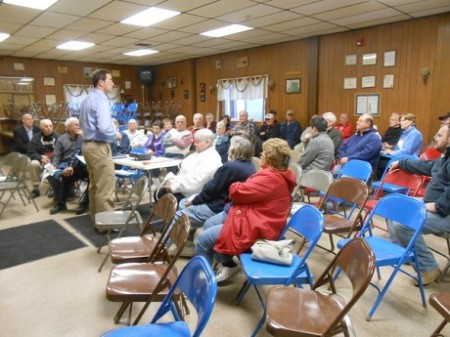BP pulling out of Cape Vincent after years of controversy

Richard Chandler, director of business development for BP Wind Energy North America, giving a presentation on the proposed Cape Vincent Wind Farm project at a firehouse in Three Mile Bay, April, 2013. Photo: Joanna Richards
BP announced earlier today that it’s “divesting” from the controversial Cape Vincent project it’s been working on for nearly a decade. Our reporter Joanna Richards is working on the story, but here’s a statement Joanna received from BP spokesperson Jason Ryan:
Last year, BP announced its intention to divest its wind energy development portfolio.
BP Wind Energy is concluding the divestment of the remaining assets in its wind development portfolio, and proceeding to terminate our position in the Cape Vincent, NY wind farm. With this termination, Cape Vincent Wind Power LLC, will withdraw from the New York State Article 10 permitting process and will wind down all of its contracts and agreements for the project. We expect this to be completed in the coming months.
BP has spent the last six years working with a wide range of stakeholders and community groups in Cape Vincent and throughout Jefferson County on the proposed wind farm. We thank them for their engagement and co-operation during this time.
The terms of divested assets are confidential.
BP is retaining operating wind farms in its portfolio at this time. Our focus remains on ensuring safe and reliable operations, and on maximizing the financial and operational performance of the existing assets.
Tags: bp, cape vincent, energy, environment, wind power








Stakeholders……. The “stakeholders” are the ones who have killed this project…not because of environmental, or quality of life issues, but because of wanting, each and every one, to get their million bucks. Greed, avarice, and covetousness have turned the discussions into a farce, and the end result is no project, no development, no green power…and no millions for anyone. Good work.
Don’t blame them at all for pulling out after years of trying to do this project , Maybe they should put a coal plant or some nuke plant down there instead of the windmills and clean energy .
Hey this is all about jobs creation right, economic development at its best! Better to get our people back on welfare that way jobs at the DSS are protected.
January 29, 2014, from windpowermonthly.com
Referring to the President’s State of the Union Address:
“In contrast to previous addresses, Obama failed to mention wind energy despite questions over the future of the current incentives [program].”
That kind of knocks the wind of one’s sails, now doesn’t it!
Perhaps the old adage about building a better mouse trap is out of style. Or maybe the idea of “if you throw enough money at a problem a genius will surface.” Seems to me that having a grid designed 100 plus years ago for constant input ( hydro) instead of an intermittent source (wind ) might have some thing to do with BPs decision. Then maybe it was the lack of a local robust grid system to transmit the intermittent power they could generate, when they found a buyer for their power. Remember the debacle as regards Galoo island project. Wasn’t the transmission issue that killed that deal- it was lack of some entity to purchase their power. Oh right, BP felt pity for the raptors and migratory critters their environment saving 500 foot towers might decimate. That might all be a bit too much for some to digest so let’s instead simply blame the greedy tax paying second home owners trying to maintain their second home’s property value by keeping one more environmentally inappropriate industrial development out of the Thousand Island region. Just maybe without this inappropriate development we can market the 1000 Islands as the truly beautiful and enique l region it is….like the Rocky Mountains or the Grand Canyon. A one of a kind region to be valued, not ruinously exploited.
The greed had little to do with the specialness of Cape Vincent. What ruined this project was a few who stood to make millions, and the rest who stood to make squat….it’s a perfect recipe for corruption, resentment, and failure.
The sad and stupid thing is that this is the manner in which all of these projects are arranged. Step one; Sign contracts with (already well off) large landowners. Step two; Ignore smallholding neighbors. Step three; Spread information (rumors) about the tremendous income to the local tax jurisdiction. And step four; Call a meeting to announce the plan. Everything about this methodology annoys the heck out of people, and as long as this is the practice, these projects will have trouble.
The north country is a poor area, like it or not, that may pop the illusion of the second home crowd about who they are living with, fine let this go and maybe BP did not do any of this correctly; but I don’t see any great jobs programs on the horizon, but then maybe that is the point? Cleanse the area of actual working people.